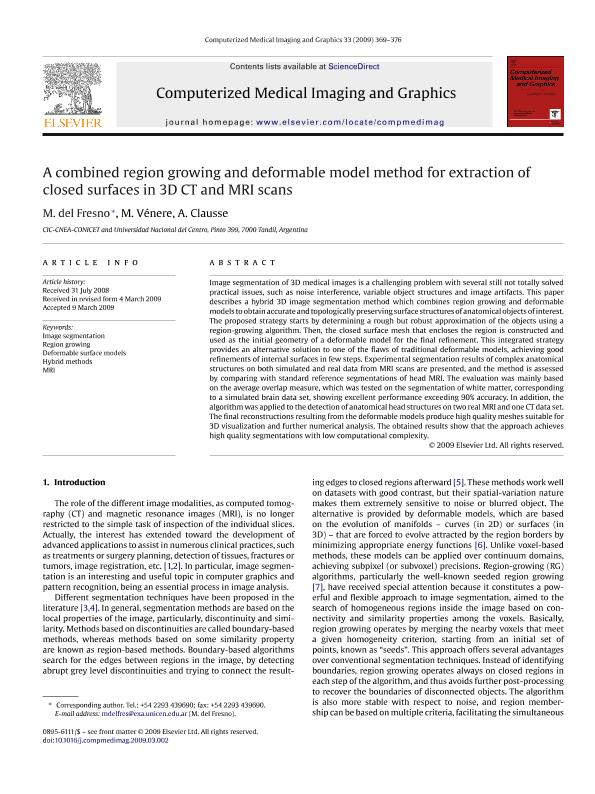Mostrar el registro sencillo del ítem
dc.contributor.author
del Fresno, Mirta Mariana

dc.contributor.author
Vénere, M.
dc.contributor.author
Clausse, Alejandro

dc.date.available
2022-11-22T15:49:45Z
dc.date.issued
2009-07
dc.identifier.citation
del Fresno, Mirta Mariana; Vénere, M.; Clausse, Alejandro; A combined region growing and deformable model method for extraction of closed surfaces in 3D CT and MRI scans; Pergamon-Elsevier Science Ltd; Computerized Medical Imaging and Graphics; 33; 5; 7-2009; 369-376
dc.identifier.issn
0895-6111
dc.identifier.uri
http://hdl.handle.net/11336/178560
dc.description.abstract
Image segmentation of 3D medical images is a challenging problem with several still not totally solved practical issues, such as noise interference, variable object structures and image artifacts. This paper describes a hybrid 3D image segmentation method which combines region growing and deformable models to obtain accurate and topologically preserving surface structures of anatomical objects of interest. The proposed strategy starts by determining a rough but robust approximation of the objects using a region-growing algorithm. Then, the closed surface mesh that encloses the region is constructed and used as the initial geometry of a deformable model for the final refinement. This integrated strategy provides an alternative solution to one of the flaws of traditional deformable models, achieving good refinements of internal surfaces in few steps. Experimental segmentation results of complex anatomical structures on both simulated and real data from MRI scans are presented, and the method is assessed by comparing with standard reference segmentations of head MRI. The evaluation was mainly based on the average overlap measure, which was tested on the segmentation of white matter, corresponding to a simulated brain data set, showing excellent performance exceeding 90% accuracy. In addition, the algorithm was applied to the detection of anatomical head structures on two real MRI and one CT data set. The final reconstructions resulting from the deformable models produce high quality meshes suitable for 3D visualization and further numerical analysis. The obtained results show that the approach achieves high quality segmentations with low computational complexity.
dc.format
application/pdf
dc.language.iso
eng
dc.publisher
Pergamon-Elsevier Science Ltd

dc.rights
info:eu-repo/semantics/openAccess
dc.rights.uri
https://creativecommons.org/licenses/by-nc-sa/2.5/ar/
dc.subject
DEFORMABLE SURFACE MODELS
dc.subject
HYBRID METHODS
dc.subject
IMAGE SEGMENTATION
dc.subject
MRI
dc.subject
REGION GROWING
dc.subject.classification
Ciencias de la Computación

dc.subject.classification
Ciencias de la Computación e Información

dc.subject.classification
CIENCIAS NATURALES Y EXACTAS

dc.title
A combined region growing and deformable model method for extraction of closed surfaces in 3D CT and MRI scans
dc.type
info:eu-repo/semantics/article
dc.type
info:ar-repo/semantics/artículo
dc.type
info:eu-repo/semantics/publishedVersion
dc.date.updated
2021-06-07T16:58:29Z
dc.journal.volume
33
dc.journal.number
5
dc.journal.pagination
369-376
dc.journal.pais
Países Bajos

dc.journal.ciudad
Amsterdam
dc.description.fil
Fil: del Fresno, Mirta Mariana. Comisión Nacional de Energía Atómica; Argentina. Universidad Nacional del Centro de la Provincia de Buenos Aires; Argentina
dc.description.fil
Fil: Vénere, M.. Comisión Nacional de Energía Atómica; Argentina. Universidad Nacional del Centro de la Provincia de Buenos Aires; Argentina
dc.description.fil
Fil: Clausse, Alejandro. Consejo Nacional de Investigaciones Científicas y Técnicas. Centro Científico Tecnológico Conicet - Tandil; Argentina. Universidad Nacional del Centro de la Provincia de Buenos Aires; Argentina. Comisión Nacional de Energía Atómica; Argentina
dc.journal.title
Computerized Medical Imaging and Graphics

dc.relation.alternativeid
info:eu-repo/semantics/altIdentifier/url/https://www.sciencedirect.com/science/article/pii/S0895611109000251
dc.relation.alternativeid
info:eu-repo/semantics/altIdentifier/doi/https://doi.org/10.1016/j.compmedimag.2009.03.002
Archivos asociados
